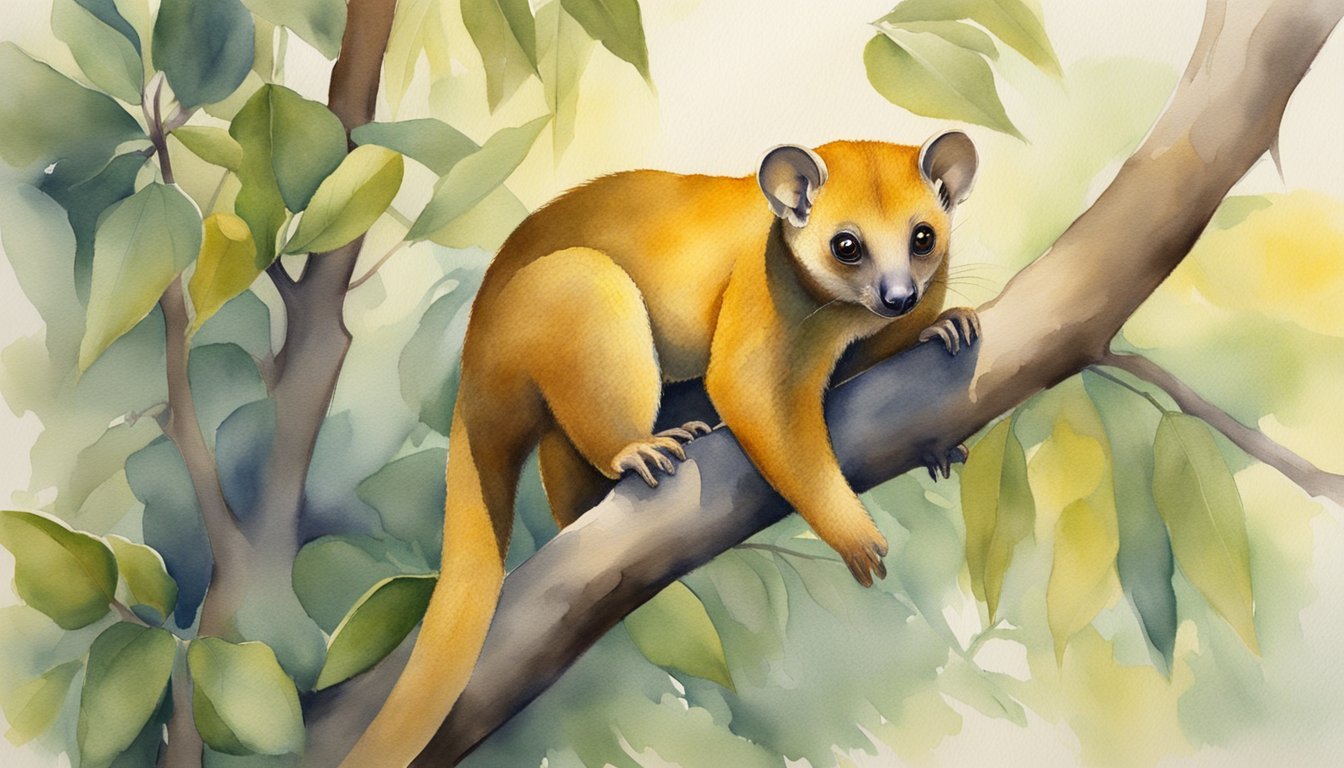Kinkajou Characteristics

The kinkajou is a unique mammal notable for its physical adaptations for arboreal life, such as a prehensile tail, and its nocturnal habits. They are also known for their varied diet that primarily includes fruits but also encompasses other food sources.
Physical Traits
Kinkajous are small to medium-sized mammals with a body length ranging from 40 to 60 centimeters (16 to 24 inches) and a prehensile tail of similar length, which aids in climbing and maintaining balance in the trees. They belong to the order Carnivora and the family Procyonidae, which makes them relatives of the raccoon. However, their physical appearance and arboreal lifestyle have often prompted comparisons to primates. Kinkajous have a dense, gold-brown coat that provides camouflage in the tropical forest canopies where they reside.
- Appearance:
- Wooly fur, gold-brown in color, with undercoat to repel water
- Round head with large eyes and small, rounded ears
- Sharp teeth adapted for varied diet
- Fully prehensile tail, used as a fifth limb
Dietary Habits
Although part of the order Carnivora, kinkajous have a predominantly frugivorous diet, relying heavily on fruit to meet their nutritional needs. They also consume insects, nectar from flowers, and occasionally eggs and small vertebrates. Their long tongues, which can extend nearly 13 cm, are especially useful in extracting nectar, making them important pollinators in their ecosystem.
- Diet:
- Primary: Fruit
- Secondary: Insects, nectar, eggs
- Role as pollinators due to long tongue
Nocturnal Lifestyle
Kinkajous are nocturnal creatures, conducting most of their activities under the cover of night. Their large eyes are an adaptation to their nighttime lifestyle, enhancing their ability to see in low light conditions. They spend the day sleeping in tree hollows or shaded tangles of leaves, alone or in small groups. Their nightly routines include foraging for food, social interactions through vocalizations, and grooming themselves with their comb-like teeth and scent glands.
- Behavior:
- Active at night, foraging and socializing
- Sleep during the day in tree hollows or foliage
- Use of vocalizations and scent glands for communication
This nocturnal mammal, often termed the “honey bear,” plays a significant role in the ecosystem of rainforests and tropical forests due to its diet and habits. Despite being widespread, kinkajous’ arboreal and nocturnal nature makes them a less commonly observed species, contributing to their air of mystery.
Kinkajou Habitat and Social Behavior

The kinkajou, part of the Procyonidae family, finds home in the lush treetops of Central and South America’s rainforests. These arboreal mammals maintain complex social structures and exhibit unique behaviors, pivotal for their coexistence in the wild.
Living Environments
Kinkajous thrive in a variety of forest environments, including tropical rainforests, mountain forests, and even dry forests. Their habitats are typically dense with foliage that provides cover and a high canopy that enables their arboreal lifestyle. These creatures often dwell in the hollows of trees or construct leafy nests for resting. The tropical regions of Central and South America, including countries like Suriname and Bolivia, offer the extensive forested areas that kinkajous need for shelter and foraging.
Social Structures
Despite being largely solitary, kinkajous have intricate social behaviors. They form small, flexible social groups that sometimes consist of related females and their offspring, or a mix of adults and juveniles. Communication among kinkajous is highly vocal; they convey messages through varied sounds, including barks and screams. Often, treetop gatherings involve activities like reciprocal grooming, which reinforce social bonds.
Reproduction and Life Cycle
Reproduction in kinkajous involves males competing for the attention of receptive females. After a gestation period, typically a single offspring—rarely twins—is born. The young kinkajou, or cub, will rely on its mother for nourishment and protection in the initial months. Kinkajous have prehensile tails, which are also instrumental for the cubs to maintain balance and navigate the treetops. Through the growth period, socialization within the troop helps the young learn necessary survival skills. Kinkajous can have a relatively long lifespan; in the ideal conditions of their natural habitat or in protective settings like a zoo, they can live up to twenty years.

